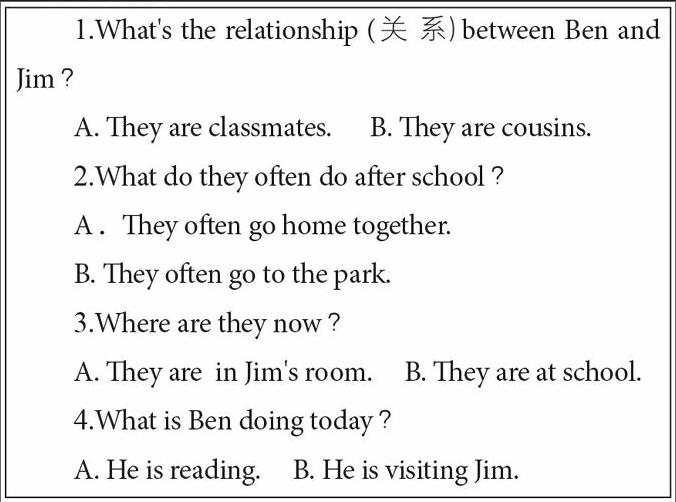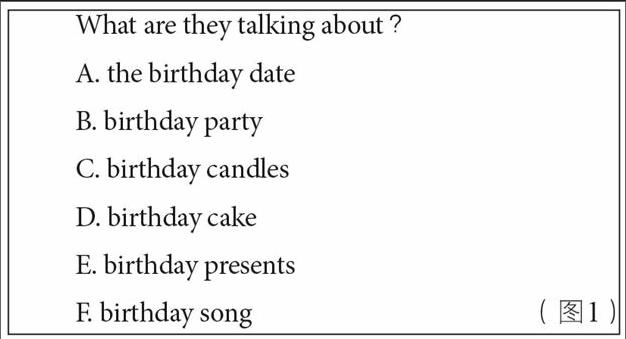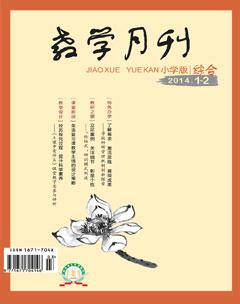架桥助学 提高实效
王春华



《牛津小学英语》高年级的语篇篇幅较长,内容较复杂,包含较多的信息和新词新句,学生学习很容易抓不住要点,理不清文本脉络,造成学习困难,这就需要教师根据学生的认知水平和学习情感,总结新旧知识间的相互联系和文本特点,给学生伸出援助之手——努力为学生的有效学习和思维激发铺路搭桥。下面笔者结合6A Unit 2 Ben's birthday的一堂教研课,谈谈如何在语篇教学中为学生“架桥助学”,提高语篇教学实效。
一、温旧知,为新知学习架“迁移桥”
旧知是指学生已经学过的知识,有些已经掌握,有些还没掌握或者说掌握得不牢固,而且根据记忆的规律,这些知识部分是会遗忘的。因此,如果在上课时直接进入新课的学习,就会人为地构成旧知与新知间的沟壑,使学生一下子难以适应新知的学习,而对旧知进行有效的温习,能使新知和旧知间相互关联,有效地实现知识与情感的正迁移。
片段1:T:Boys and girls , we learnt the month and the date. First , let's say the months together.
Ss:( Say the months together.) (学生依次从1月说到12月)
T:Good. Let's play a game. Who can say quicklier ?(PPT呈现不同的月份)
Ss:February , December , October...(学生根据PPT呈现的月份抢答)
T:OK. Now , can you say something according to the key words?(PPT呈现:5月1日 , Helen , park) For example:Today is the first of May. Helen is in the park. She is catching insects. Can you say something like me?
Ss: Yes.
T: (PPT呈现:12月5日, Tom's birthday, eat, KFC)Who can try?
S1: Tom's birthday is on the fifth of Dec. He would like to eat KFC.
S2: Today is the fifth of Dec. Tom's birthday is coming soon. He would like to eat KFC.
T: Good. Look at these key words. Who can say?(PPT呈现:2月23日, Mr Wang, party, bike)
S1: Mr Wang's birthday is on the 23rd of Feb. He rides his bike at his birthday party.
S2: Today is the 23rd of Feb. It is Mr Wang's birthday. He would like a bike as his birthday present. He wants to have a birthday party.
本课中12个月份的读音和日期的表达是相当难的,学生通过第一课时的学习,肯定会有遗忘,所以,一上课就让学生按顺序复习说月份,然后打乱顺序说。通过两轮的复习,能较好地唤醒学生对月份的记忆,然后再过渡到谈论日期和看关键词说句子(含有日期)。通过多方位的复习巩固,慢慢地与本课的学习产生联系,实现了知识和情感的正迁移,为本堂课的有效学习做好了充分准备。
二、引话题,为文本学习架“兴趣桥”
文本与学生之间是有一定距离的,当这个距离偏大时,就难以激发学生的阅读兴趣。因此,教师要根据文本内容,结合学生的生活实际和能力情况,创设有效的情境,引出与文本内容相关或相近的话题,与学生交流讨论。这样,学生就会对文本内容充满兴趣,激发阅读冲动,从而为有效文本学习做好准备。
片段2:T: My birthday is on the 23rd of Feb. And I would like a bike as my birthday present. How about you? When's your birthday?
S1: My birthday's on the ...
T: What would you like as a birthday present?
S1: I'd like...
T:Would you like to have a birthday party?(PPT呈现 Yes , I'd like to.)
S:Yes , Id like to.
T:Good , Let's talk about our birthday together.
Ss:Work in pairs.(略)
T:Today , Ben and Jim will also talk about their birthdays . Do you want to know any information about them?
Ss:Yes...
笔者先引导学生谈论自己的生日、想得到的生日礼物、想要举行的生日聚会,然后过渡到课文的主人公及他想要得到的生日礼物。由于话题相似,学生学得更有兴趣,文本阅读兴趣被激发。
三、降难度,为文本解读架“信心桥”
在语篇学习中,由于学生的词汇量较少,理解能力较差,语言组织能力和综合运用能力相对较弱,所以,一些学生对教师提出的问题感到难理解,或难以用自己的语言来陈述自己的观点,产生畏难情绪。因此,要降低难度,让学生对文本解读有足够的心理准备和能力准备,让学生成为学习的强者。
片段3:T: Let's listen and find the answer. (PPT呈现如下内容)
Ss:(Listen and choose.)
T:(学生完成后)Who can answer the questions?(很多学生举手) Q1: What's the relationship(关系) between Ben and Jim?
S1: They are classmates. Choose A.
T: You're right. What do they often do after school?
S2: They often go home together.
对于小学生来说,听录音并理解其中的主要内容和回答相关问题是有难度的,往往只有极少数的优等生才能做到,但如果像案例中以选择的形式呈现给学生,那么难度就降了很多,学生对录音内容记忆的量就减少了,当他们听到相关内容时,只要判断选择便可。同时,在回答问题时,由于有选项的辅助,学生语言的重组量减少了,语言组织难度降低了,学生回答起来就得心应手了。
四、提主线,为文本分析架“逻辑桥”
小学高年级的语篇内容丰富,篇幅较长,语言知识点多,如果教学缺少主线,东一榔头西一锤,往往会使教学陷入无序化状态,学生学得糊里糊涂。因此,语篇教学呼唤教学主线。明晰的教学主线就好比一条“精品旅游路线”,把学生带进“一处处风光秀丽的景点”,使一堂课显得有条有理、环环相扣,且重点突出、精彩纷呈。
片段4:T:We know, they are talking about Ben's birthday. What are they talking about the birthday?Can you guess?
S1: I think they are talking about the birthday party.
T:Maybe.
S2:I think they are talking about the birthday.
T:Perhaps they do.
S3:I think they are talking about the birthday present...
T:Good . Now,let's watch the cartoons and find what they are talking about.(PPT 出示图1)
Ss:( Watch the cartoon of part A.)
T: Have you got the answers?Who can say?
S4:They are talking about the birthday date , birthday party, birthday presents. (根据学生回答PPT将其他选项隐去,只剩A、 B、 E三项,如图2)
T:Excellent. Let's know some information about them. First , let's know the birthday date.(PPT呈现如下4个问题)
1.When's Ben's birthday ?
2.When's Jim's birthday ?
3. What date is it today?
4.Whose birthday is coming soon?
Ss:(Read and find the answer.)
(教师引导学生根据三个话题the birthday date , birthday party , birthday presents分别讨论学习文本)
在整个文本内容的解读过程中,教师在引导学生整体感知文本后,帮助学生找到文本内容的三个重要支点——the birthday date , birthday party , birthday presents , 然后再引导学生品味这三个不同“风味”的话题,步步深入,思路清晰,富有逻辑,使学生对整个文本的内容结构清清楚楚地构建起一张脉络图。
五、析对比,为文本拓展架“思维桥”
对比是把具有明显差异、矛盾和对立的双方安排在一起,进行对照比较的表现手法。教学中,将一些相似但又有所不同的单词、句子或教学内容等进行对比,能激活学生的好奇心,从而拓展文本研读的深度和广度,活跃学生的思维。
片段5:T:(教师指着板书)Please look at the board-writing. Now , we only know Ben's birthday party. But we don't know anything about Jim's. What will happen? Let's have a imagination. Who want to come to his birthday party?
S1:His friend will come to his birthday party and give him some presents.
T:What presents will they give?
S1:Yo-yo or VCD.
T:Maybe. How about his parents?
S2:They will buy him a big cake and some new clothes.
S3:They will give him a new bike.
S4:They will cook nice food for Jim.
T:Good. And what will Jim's friends and parents do at the birthday party?
S5:They will sing the song “Happy birthday to you” to Jim.
S6:They will eat the cake.
S7:They will ask Jim to make a wish.
S8: They will play some games.
T:Very Good. I think , everyone has your opinion. Please take out your exercise paper and write your idea.
Ss:略(学生想象写作)
本片段中,教师通过让学生对比板书中的内容,让学生在对比中发现Jim生日聚会内容的空缺,既从整体上对文本内容进行了一次再梳理,同时又通过板书对比给学生一种较强的视觉冲击,激起了学生的好奇心,让学生欲罢不能。教师的提问正中学生的下怀,开启了学生的思维之门,他们或想象着自己或朋友过生日的情景;或想象着电视里看到的场景;或想象着自己理想中的生日聚会场景;这种想象基于文本而又高于文本,是对文本的拓展和延伸。
语篇学习中,当教师为学生架起一座座前行的“助学”之桥时,学生有了走近文本的自信和从容,文本中的知识点似乎变得多味了,文本内容似乎变得简单了,文本的脉络似乎变得清晰了。学生在辅助桥的引导下,一点点地收获新知,一次次地克服难题,一步步地深入文本,快乐地畅游在语篇的花园里。
(江苏省苏州市吴中区藏书实验小学 215156)

